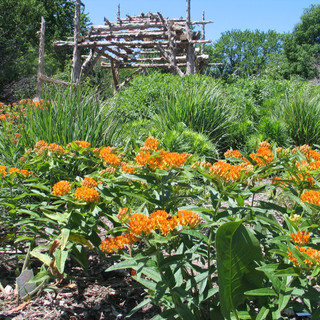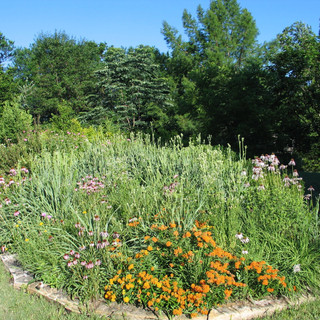
ONCE UPON A PRAIRIE: NORTH AMERICA'S LARGEST ECOSYSTEM, with BRAD GUHR, DYCK ARBORETUM OF THE PLAINS
Last week we talked "Little House on the Prairie" and this we visit the grassland prairies and plains of Kansas. We joined by Brad Guhr of The Dyck Arboretum of the Plains in Hesston, Kansas.
The Dyck Arboretum of the Plains was founded by Evie and Harold Dyck, who wanted to make a gift to their community of a natural space for solitude and quiet reflection, a sanctuary for humans and for the native plants and landscapes of Kansas – that they loved. Brad Guhr is the education coordinator and prairie restoration specialist on staff at the Dyck Arboretum of the Plains, part of Hesston College in Hesston, Kansas where he helps manifest the dreams of Harold and Evie Dyck.
Natives of Kansas, Harold and Evie were inspired by their love of the Kansas landscapes to create the public garden sanctuary for the benefit and education of people and for the preservation of native plants of Kansas. The Dyck Arboretum today is a 33-acre interpretive center demonstrating climate appropriate horticultural uses of native plants of the prairies and plains, including an 18-acre Prairie Window Project.
According to the Tallgrass Prairie National Preserve in Kansas and the Ladybird Johnson Wildflower Center in Texas, tallgrass prairie once covered between 170 to 250 million acres of North America – making it the largest ecosystem in the country. By 1860, the vast majority was developed and plowed under. Today less than 4% remains, mostly in the Kansas Flint Hills. Stretching over 250 million acres, the tallgrass prairie was once the largest ecosystem in the United States.
Grasslands and prairies are evocative landscapes – sweeping, open horizons – the phrase sea of grass speaks to the rhythmic movement of wind, sky, weather, and the rippling grasses in all seasons. Despite having signature plant communities, they are also crucial ecosystems for many of our insects, birds and mammals who winter or summer in these environments.
Native grasses form the base of the prairie framework, accounting for between 50 and 95 percent of the vegetation. The four dominant species in the tallgrass prairie are the four different bunch grasses: little bluestem (Schizachyrium scoparium), big bluestem (Andropogon gerardi), Indiangrass (Sorghastrum nutans) , and switchgrass (Panicum virgatum). I find it interesting that they are from four different genera. 100s of species of forbs or broadleaf herbs, which includes the wildflowers, are also an integral part of the prairie, providing the bulk of the species diversity – and seasonal color.
“The prairie is as awe inspiring as the mountains or the redwood forests - you just have to get closer to it to realize that. It’s not until you get closer to it that you see those 100s of species of grasses and wildflowers that create that interesting part of that basis of the foodweb - then when you’re in there, you get to see the amazing interactions with the pollinators…a prairie provides so many important and sometimes forgotten services of helping filter stormwater on the landscape and helping refresh the air that we breathe, some of those very concepts are important to human health."
Brad Guhr, Education Coordinator & Prairie Restoration Ecologist,
Dyck Arboretum of the Plains, Hesston, Kansas
*****
Something that really moves me about this conversation with Brad Guhr is the power of just one or two impassioned people. The National Tallgrass Prairie Preserve in Kansas the Ladybird Johnson Wildflower Center in Texas and the Aldo Leopold Foundation in Wisconsin are all doing amazing work in this world to educate us and provide us passionate plant folk with more resources. These are names you perhaps know and I will certainly hope to host episodes with these organizations in time, but the Dycks were two ordinary citizens in a tiny agricultural town in central Kansas. And they acted on their love of their native landscapes – that inspires me as much as these landscapes do and reminds me of the power and potential of even our small and individual actions in our gardens and hometowns. Horticultural heroics.
Talking with Brad today has brought up a great memory I have of epic grasslands and their beauty, when as a young girl I got to go camping with my father – a wildlife biologist – on the Pawnee National Grasslands in northern Colorado. Maybe it was an upland game hunting trip? Maybe he was collecting research data? I don’t recall that part, but it was the first time I’d heard the name grassland prairie specifically applied to a landscape I was experiencing - and it stuck with me.
The big open plain and the summer colored blue green grasses extended for miles – you could hear everything – you could see weather forming and hear the slightest wind shhhsshin through the grasses. It was - beautiful. I could hear myself think. I could see very tangibly just how small I was, and it was not scary - it was exhilarating.
Do you have landscape memories like this – new or old? If you feel like sharing – send me a note by email or on Facebook or Instagram. OR better yet – send me a voice memo from your smart phone – 1 minute or less – sharing your memory! YES! If you’re not sure how, let me know and I’ll walk you through it. Sarah B (our producer over here at CP) and I would love to hear your voices! We can be reached at cultivatingplace@gmail.com.
Some great Prairie Education Resources:
https://www.nps.gov/tapr/learn/nature/plants-at-the-preserve.htm
https://www.wildflower.org/collections/collection.php?collection=ss_06
https://www.aldoleopold.org/
http://kansasecomeet.org/ecomeet/wp-content/uploads/2012/05/FHWPocketGuide.pdf
Cultivating Place is an award-winning co-production of North State Public Radio, where it airs every Thursday at 10 am PST.
Join the Cultivating Place Community on Instagram or Facebook. AND Sign up for the monthly newsletter, so that I can hear from YOU.






















































